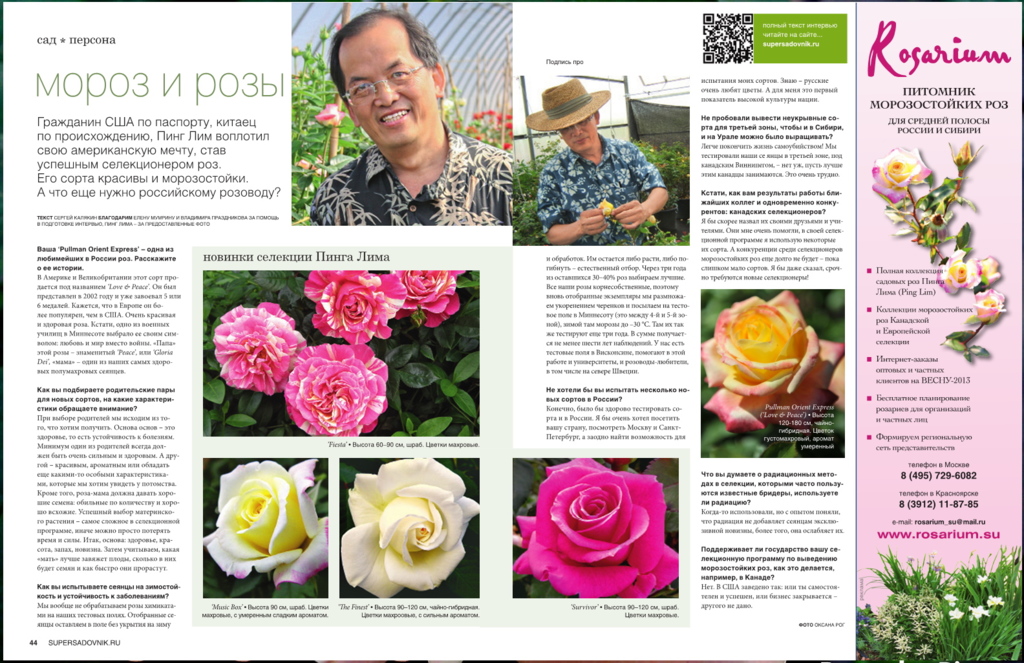Interview with



These two articles repeatedly emphasized that roses bred by
One of the authors, Ksenia Surina, a European rose adjudicator, generously claimed that


These reports caught the attention of Sergey Kalyakin, the deputy Editor-in-Chief of Sadovnik (Gardener) magazine from

I am flattered and thankful for the interview from this great nation which was posted on March 18, the website and published in two full-color pages, some of Roses by Ping cultivars also promoted on the edge page, most of these roses are available and can be purchased in nursery around Moscow, including the popular "love and Peace" and the latest bi-color variety: "Music Box".
It is translated by Google then edited by Jana Lim from Russian original text, I try to keep the original version without much supplement modification:
The following is the interview report from Sergey Kalyakin, Chief editor of The Gardener the magazine from
Editor :Your 'Pullman Orient Express' is one of the most popular roses in
Ping :In
Editor :How do you choose a pair of parents for new bred varieties on what characteristics to look for?
Ping:When selecting "parents" we believe in what we want to get. The basic foundation of the goals must be set, that is, resistance to disease. At least one of the "parents" always has to be very strong and healthy. And the other must carry beauty, fragrance, or have even some other features that we want to see in the offspring. In addition, the rose-"mother" should set good seeds - abundant in number and well-germinating. Successful choice of the mother plant is the most difficult in the breeding program, or you may just lose time and effort. Thus, the basics are : health, beauty, fragrance, novelty. Then I consider which "mother" will create the best results.
Editor :What is your experience on the seedlings trial for winter hardiness and disease resistance?
Ping:We generally do not treat roses on our test fields with chemicals. Selected seedlings are left in the field without shelter for the winter and treatments. They have to either grow or perish, so-called natural selection. After three years field testing, only 30-40% remain at their best. These are all original own-rooted roses (none budded), so again, we multiply by own root those selected cuttings and send to further field test field in Minnesota (it's between zone 4 and 5) and even test in the winter there frosts down to -30 degrees(Canada), continue tested in the same way for the next three years. So it takes a minimum of six years of observation before introduce to commercial. We have test fields around the nation, and have University researchers and Rosarians help us to evaluate the plants. The northern
Editor :Would you like to try out a few new varieties in
Ping: Of course, it would be great to test varieties in
Editor :Do you try to breed hardy without protection roses for zone 3, such as testing in
Editor :By the way, how are the results of your closest colleagues and competitors at the same time - Canadian breeders?
!
Editor :What do you think of radiation techniques in breeding, which often are applied by breeders themselves?
Editor :Does your government support or funding your breeding program for cold-resistant roses, as it’s done in
Photo of new novelty selections from
'Music Box': Height 90 cm, shrub. The flowers are double, with a moderate sweet fragrance.
'Survivor':Height of 90-120 cm, shrub. Flowers double.
'Fiesta':Height of 60-90 cm, shrub. Flowers double.
'The Finest':Height of 90-120 cm, Hybrid Tea. flowers with a strong fragrance.
'Love and Peace':Height of 120-180 cm, Hybrid Tea.fully double flowers, moderate fragrance.
Text: Sergey Kalyakin and
(translation Russian to English by Google, edited by Jana Lim, authenticated by Sergey Kalyakin)
References:
http://rosarium.su/publikatsii/kak-i-za-chto-sudyat-rozy.html
http://rosarium.su/publikatsii/krasota-po-amerikanski.html
http://www.supersadovnik.ru/article_plant.aspx?id=1003768





